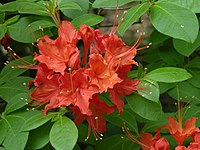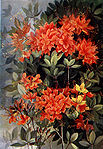| Flame azalea | |
|---|---|

| |
| At Craggy Gardens, North Carolina | |
|
Scientific classification
| |
| Kingdom: | Plantae |
| Clade: | Tracheophytes |
| Clade: | Angiosperms |
| Clade: | Eudicots |
| Clade: | Asterids |
| Order: | Ericales |
| Family: | Ericaceae |
| Genus: | Rhododendron |
| Subgenus: | Rhododendron subg. Hymenanthes |
| Section: | Rhododendron sect. Pentanthera |
| Species: | R. calendulaceum
|
| Binomial name | |
| Rhododendron calendulaceum | |
| Synonyms [2] | |
|
Synonymy
| |
Rhododendron calendulaceum, the flame azalea, [3] is a species of Rhododendron. It is a deciduous shrub that grows up to 120–450 cm tall. This species of Rhododendron is native to the Appalachian Mountains in the eastern United States, ranging from southern Pennsylvania and Ohio to northern Georgia. It may be extirpated from Pennsylvania and Alabama. [4] It occurs naturally in mixed deciduous forests and is typically found in woodland slopes and mountain balds in the Appalachians, [5] where it prefers dry and rocky mountain woods. [6] The inflorescences of Rhododendron calendulaceum are visited by many animals such as bees, butterflies, hummingbirds and small mammals. [5] It is a popular cultivated plant due to its bright yellow, orange or red flowers.
Description
It is a deciduous shrub, 120–450 cm tall. The leaves are simple, 3–7 cm long, slightly dull green above and villous below. The arrangement is generally alternate, however they appear whorled towards the tips of the branches.
The flowers are 4–5 cm long, usually bright orange, but can vary from pastel orange to dark reddish-orange. These non-fragrant flowers have 4-5 lobes and grow in clusters of 5–10. It typically blooms in late May and early June. [5] [7]
Variation in wild populations
Rhododendron calendulaceum is a highly variable species. The flowers of Rhododendron calendulaceum can range from light yellow to orange and rarely, a scarlet red. Some flowers appear to be a blend of multiple colors, and others seem to have secondary pigments such as pink or red. Some have even reported a white flower in Rhododendron calendulaceum, however these records cannot be verified. The buds of Rhododendron calendulaceum are typically a darker color than the mature flower, however some flowers deepen in color with age. In some plants, a full range of colors such as yellows, oranges and reds can be present on the same plant. It is possible that color change is affected by light, with flowers in shadier areas exhibiting less color change compared to plants in open spaces. [8]
The flower sizes in Rhododendron calendulaceum are also variable, with a typical flower size of 2-2.5 inches. Some flowers have blossoms of less than an inch, while others can be up to 3 inches. [8]
-
Yellow flowers
-
Deep orange flowers
-
Flower buds
Ecology
The inflorescences of Rhododendron calendulaceum are visited by a diverse group of animals such as bees, butterflies, hummingbirds and small mammals. [5] The flowers can only be pollinated by the wings of butterflies. Only Papilio glaucus and Speyeria cybele have been observed pollinating the flowers. P. glaucus is more effective in pollination due to differences in wing flapping behavior. [9] Rhododendron calendulaceum is a host of the fungus Exobasidium vaccinii. E. vaccinii negatively affects the reproduction and health of the flowers and branches of Rhododendron calendulaceum. [10] The insect Rhinocapsus vanduzeei is known to feed on the stamens of Rhododendron calendulaceum flowers. [11]
Distribution and habitat
This species of Rhododendron is native to the Appalachian Mountains in the eastern United States, ranging from southern Pennsylvania and Ohio to northern Georgia. It may be extirpated from Pennsylvania and Alabama. [4] The state of Pennsylvania lists Rhododendron calendulaceum as extirpated from the state. [12] It has been reported historically in New York and Maryland, however, its current native status in these states is undetermined. [13] However, it can occur as an introduced species in anthropogenic habitats. It occurs naturally in mixed deciduous forests. It is typically found in woodland slopes and mountain balds in the Appalachians, [5] where it prefers dry and rocky mountain woods. [6] It lives in a variety of forest ecosystems such as Loblolly-shortleaf pine, oak-hickory and maple-beech-birch forests. It prefers to be covered by Quercus montana, Quercus alba, Quercus velutina and Quercus rubra. Rhododendron calendulaceum primarily occurs in mixed deciduous forests. It is found in the well-developed shrub layer of oaks with southern and western sun exposure. It is commonly found in ravines with mesic soil. Rhododendron calendulaceum is an important understory shrub in forests that were formerly co-dominated by the American chestnut. Rhododendron calendulaceum commonly occurs with other ericaceous shrubs including Rhododendron maximum, Kalmia latifolia, Vaccinium corymbosum, and Gaylussacia spp. Rhododendron calendulaceum commonly occurs in oak forest that periodically see fire. [14] Rhododendron calendulaceum grows in well-drained, mesic to moist, medium to fine textured soils in part shade. Rhododendron calendulaceum prefers a pH range of 4.3 to 5.8. Rhododendron calendulaceum requires a minimum soil depth of 14 in. Rhododendron calendulaceum requires at least a 200 day growing season. [15]

Horticulture
The flame azalea is a popular cultivated plant, primarily due to its showy flowers. Many cultivars and domestic varieties exist, including Chattooga, Cherokee, Golden Sunset Flame, Golden Yellow Flame, Smokey Mountaineer and Wahsega. [7] It is also an important parent species in hybrid Azaleas, such as, Ghent, Knap Hill, Maid in the Shade, Mollis and Northern Lights. [16]
-
'Mandarin Red' cultivar
See also
References
- ^ "NatureServe Explorer 2.0". explorer.natureserve.org. Retrieved 20 December 2023.
- ^ "Rhododendron calendulaceum". POWO. Retrieved 20 December 2023.
- ^ USDA, NRCS (n.d.). "Rhododendron calendulaceum". The PLANTS Database (plants.usda.gov). Greensboro, North Carolina: National Plant Data Team. Retrieved 21 October 2015.
- ^ a b "Flame Azalea" (PDF). vnps.org. Virginia Native Plant Society. 2000. Retrieved 21 December 2023.
- ^ a b c d e "Rhododendron calendulaceum (Flame Azalea) | North Carolina Extension Gardener Plant Toolbox". plants.ces.ncsu.edu. Retrieved 2020-06-10.
- ^ a b "Rhododendron calendulaceum". www.wildflower.org. Retrieved 10 December 2023.
- ^ a b Brand, Mark H. "Plant Database". www.hort.uconn.edu. Retrieved 2020-06-10.
- ^ a b Hyatt, Donald W.; McLellan, George Keen. "Rhododendron calendulaceum: Variations in the Wild" (PDF). Yearbook of the Rhododendron Species Foundation Botanical Garden. Retrieved 19 December 2023.
- ^ Epps, Mary Jane; Allison, Suzanne E.; Wolfe, Lorne M.; McPeek, Mark A. (2 August 2015). "Reproduction in Flame Azalea (Rhododendron calendulaceum, Ericaceae): A Rare Case of Insect Wing Pollination". The American Naturalist. 186 (2). doi: 10.1086/682006. Retrieved 19 December 2023.
- ^ Wolfe, Lorne M.; Rissler, Leslie J (January 2000). "Reproductive consequences of a gall-inducing fungal pathogen (Exobasidium vaccinii) on Rhododendron calendulaceum (Ericaceae)". Canadian Journal of Botany. 77 (10). doi: 10.1139/b99-108. Retrieved 19 December 2023.
- ^ Wheeler, A. G. "A Potential Insect Pest of Azaleas". American Rhododendron Society. Retrieved 19 December 2023.
- ^ "CHAPTER 45. CONSERVATION OF PENNSYLVANIA NATIVE WILD PLANTS". www.pacodeandbulletin.gov. COMMONWEALTH OF PENNSYLVANIA. Retrieved 21 December 2023.
- ^ Carey, Jennifer H. (1994). "Rhododendron calendulaceum". www.fs.fed.us. Retrieved 2020-06-10.
- ^ "SPECIES: Rhododendron calendulaceum". www.fs.usda.gov. Fire Effects Information System. Retrieved 20 December 2023.
- ^ Mehl, Geoffrey (2016). Pennsylvania Naturally. Pennystone Books. p. 352. ISBN 9780986276606.
- ^ "Deciduous Azaleas". www.rhodyman.net. Retrieved 2020-06-10.
External links





